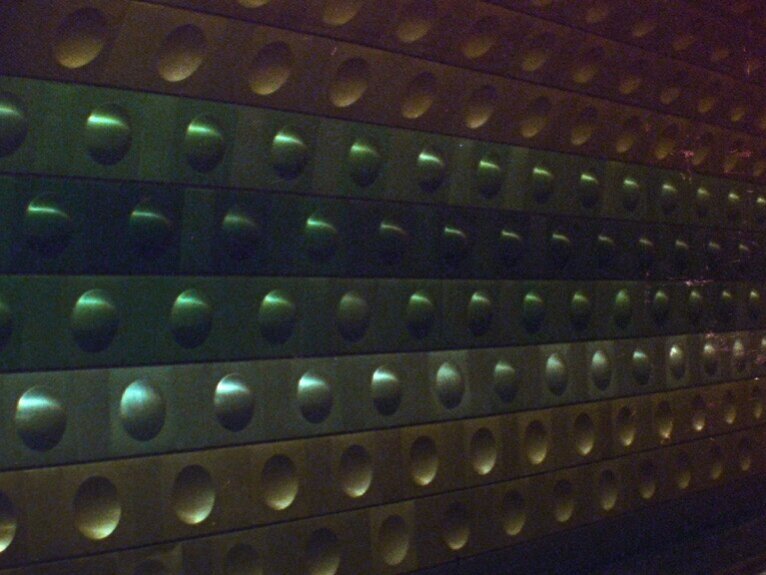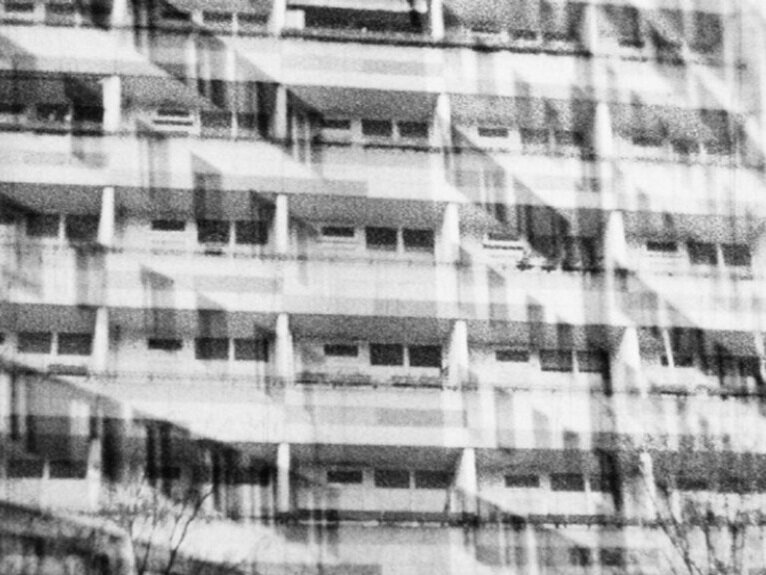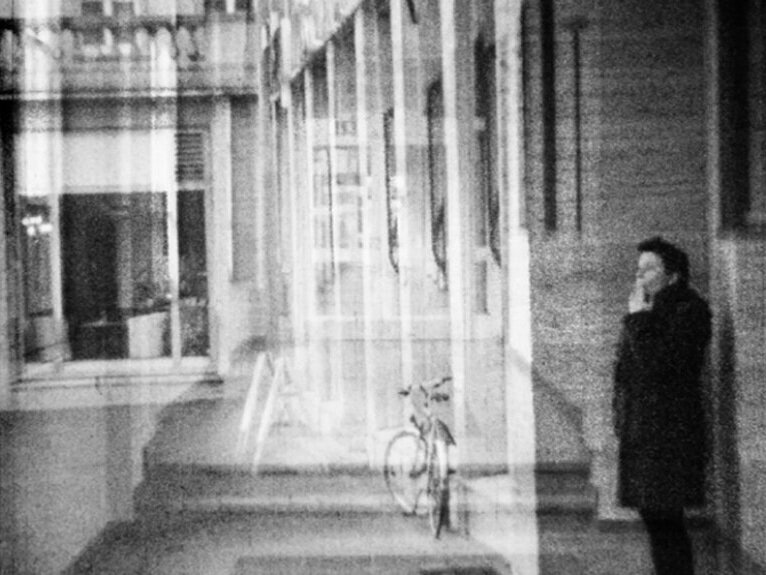AZUCENA LOSANA + VANJA MILENA MUNJIN
07.30.2020 - 08.30.2020
KARL-MARX-ALLEE by AZUCENA LOSANA / 2015 / Super 8 / 3'50" / Germany / Argentina / two-channel projection / Music: Corpiños Luminosos
The ways in which films come back to us tend to be mysterious. Suddenly a detail, a movement, a small gesture grabs us and transports us, like déjà vu, to the sensations or images from a forgotten screening that we seem to have been saving in the back of our mind. Something clicks and we have the sensation that this is only possible because something real, a real feeling, stayed in our network of images and sounds. We also understand that the films we have seen continue to inhabit us in places that are secret even to ourselves.
November 2019. I land in Berlin for the first time. I take the S-Bahn towards the north of the city and as the car hovers above the streets I look out the window trying to apprehend something from that place. I glimpse in the dark and see the forms and orders of the city, check expectations, recognize postcards or frames. Suddenly the game between crossing reflections from one window to the other and the city lights choreographed by the speed of the car seem familiar to me.
My mind travels quickly, I go back to October, auditorium room, FICValdivia, in the middle of an audiovisual journey an S8 tape begins to run through the projector and its black and white images are captured in an abrupt montage on the screen while we listen to a musical track that the director / performer is playing from her computer. She quickly jumps and grabs the tape that is moving and threads it through another projector that turns on and superimposes images of buildings, corridors, window frames and doors that are found and unsettled or whose angles are mutually muttering each other. We can recognize a waiting room, some old photographs, leafless trees and a person who seems to lean out the window and look at us.
AT YOUR HEELS by AZUCENA LOSANA / 2017 / 16mm / 2'36" / Czech Republic / Argentina
The vivid memory of Karl-Marx-Allee makes me think again about the precision with which Azucena Losana transmits the rhythm of certain cities in her short films, be it the frenzy of a megalopolis like São Paulo in SP, the siesta time in the hills of Valparaíso in Siesta or winter in Prague in At your heels. It’s in the way that she chooses to direct her gaze: towards passengers, stray animals, a street, a subway station, a building with its human, non-human, urban details; the small things that are full of life and whose shapes, colors and designs have kept something from past times.
But it’s also in the way of constructing a montage, a soundtrack, a way of projecting; that accumulation of moments, maneuvers and processes that come from traveling, looking, shooting hand-held and with celluloid, developing with one's own hands, composing sounds and projecting live what condenses in these films and in their viewing experience a particularly dreamlike thickness where everything seems to be the result of an intense, light and happy reverie.
Losana's cinema seems to resemble the discards of memory –whether they are collective, urban, social, historical–, they are that which makes up the raw material of oblivion that also seems to be what feeds the subconscious and therefore never abandons us, we only have to be attentive to find it or to look for it in the details, in fleeting moments, in distant and rhythmic sounds, textures, confusions and glitters that come back to us in our sleep and embrace us.
CORBUSIERHAUS by AZUCENA LOSANA / 2020 / 16mm / 2'42" / Germany / México
The journey continues and we move from the ghosts and dreams that rest upon and are stirred around in the streets and buildings of the old continent, towards our America. The crossing of the Atlantic takes us from Losana’s archaeological approach to the materialities and rhythms of European cities, plunging between Berlin and Prague, towards a rather anthropological drive that connects past energies with contemporary rebellions that boil, today more than ever, in Latin American cities, setting our sight on the human and non-human bodies that inhabit, perform and embody them.
SIESTA by AZUCENA LOSANA / 2018 / Super 8 / 3'16" / Chile / Argentina
Siesta captures and recreates the suspended time during which the people who reside on the hills of Valparaíso take a nap, whenthe city streets extend like a territory liberated for feline and canine activit. We find them crouching, lying down, with their hair blowing in the wind and being playful. Losana approaches them with her super 8 camera and captures them with the childlike curiosity and infinite tenderness that characterizes her; she finds frames that adapt to their movements and gestures that fill up the three minutes of film with a deep camera-animal communicability. Meanwhile, above, the windows slightly ajar with curtains blowing in the wind seem to convey the hiss in which the local humans immerse themselves for a couple of hours. In the background we hear the high-pitched and melodious whistle of a knife sharpener traversesthe hills, some crickets and animals and the indistinguishable city in the distance, a car that passes, and the sea winds that flood everything.
LANDS OF THE SEA de AZUCENA LOSANA / 2019 / Standard 8 / Super 8mm / 5'54" / Chile / Argentina
FAlso filmed in the skirts of Valparaiso, Lands of the Sea begins in standard 8 and immerses us in the cove El Membrillo, where the sun shines and dances on the coastal waves, creating abstract but recognizable forms. Meanwhile, we hear a boat in the sea accompanied by humans whistling, attempting to recreate the sound of the wind, submerging us in a kind of timeless maritime dream. The second half takes us back to super 8 film, which Losana used to record, during the Tsonami sound art festival, a performance by Leonel Vasquéz, a Colombian artist who, along with the fishermen of the cove, developed a collaborative project in which they built a wooden boat using traditional carpentry techniques which were adapted to reproduce the sounds that Vasquez recorded during the construction process. The sounds are accounts of the fisherman's life stories, their current concerns and their knowledge.
This short film gives the performance a second life by choosing two or three stories that tell the disastrous consequences that the fishing law has had on local fishermen, sinking their chance of working and living off of fishing. It also tells the story of traditional nautical carpentry, a gesture that resonates with other patterns in Losana’s filmmaking, especially present in works such as Intermission, Neón or El Guarache, in which she portrays artisanal trades that are on the brink of oblivion such as theArgentinian cinematographic technician Daniel Vicino; or César’s, a man dedicated to putting up the neon signs that still adorn some stores in Buenos Aires, or the owner of an Oaxacan artisanal mezcaleria. Always bordering between a curious look, playfulness and the mingling of forms and rhythms that are adapted to the encounter between her and her characters, these portraits acquire a double meaning since they are filmed on celluloid, a materiality and profession that, even if increasingly popular, speak to us of past ways of thinking and making movies.
LA HORA DECISIVA by AZUCENA LOSANA / 2020 / Super 8mm / 1'52" / Mexico
At the crest of this second wave in the waters of Losana, we move to her native country in La hora decisiva, where she captures, in the midst Mexican Revolution celebrations that happened in November 2019, an improvised street photography set [1], with people wearing traditional garments being photographed in an elegant armchair with a rifle in their hands, imitating the photographic records of the time. Full of humor, joy and cotillón, Losana comments that, given all the multiple protests that were taking place on the continent at that time, she wondered what Zapata would have thought of our revolutions.
Today, after several of these upheavals had to retreat due to other biological revolutions that keep us lurking from our homes, this journey through deserted cities, dreams of the past, claims and celebrations of the present that condense these short films, open the question of the real and the way of approaching it, of capturing it and translating it into cinema, giving it density and thickness, without forgetting play and tenderness.
Texto written by Vanja Milena Munjin Pavia for corrient.es, August 2020
[1] Nota de Azucena Losana: El set de fotografía en "La hora decisiva" lo montó el gobierno nacional en el zócalo del DF (la plaza central) como parte de los festejos de la revolución, que venían siendo bastante solemnes hasta que asumió este nuevo gobierno de López Obrador, que se hace llamar la cuarta transformación (la primera es la independencia, la segunda la reforma de la constitución y la tercera la revolución) y está tratando de volver a los festejos patrios más populares Azucena Losana nació en la Ciudad de México en 1977. Vive y trabaja en Buenos Aires. Cursó la Licenciatura de Artes Multimediales de la Universidad Nacional de las Artes (UNA) en Argentina, la Diplomatura de Preservación y Restauración Audiovisual (DIPRA) impartida por la Cinemateca y Archivo de la Imagen Nacional de Argentina (CINAIN) y la Universidad de Buenos Aires (UBA), el taller de Found Footage de Abigail Child y de cine experimental de Claudio Caldini. Ha trabajado con los colectivos Trinchera Ensamble y LECen México, y Circuito CiN!CO y DNI en Argentina. Su obra abarca el cine experimental, las instalaciones y el video. Lleva adelante la gestión y programación del CINEMA CINICO, una sala itinerante de proyecciones en fílmico. Desde 2015 trabaja como laboratorista en el mítico laboratorio de la resistencia fílmica en Latinoamérica: Arcoiris Super 8. Actualmente trabaja en el proyecto de la puesta en valor del acervo fílmico de la Embajada de México en Argentina. Desde 2012 realiza junto a Carolina Andreetti el Taller de Proyectores Precarios TAPP, un taller que consiste en la construcción de proyectores analógicos con materiales de descarte o fácil acceso, para ensambles audiovisuales. Recibió en 2009 el Tercer Lugar Premio Mamba Telefónica a las Nuevas Tecnologías, en 2015 la beca de intercambio de la Universidad de Sao Paulo/UNA. En 2016 una mención en el Salón Nacional de las Artes. En 2017 la beca de creación individual del Fondo Nacional de las Artes de Argentina y la beca del Sistema Nacional de Creadores FONCA México.
Sus films se han presentado en festivales como el Festival Internacional de Cine de Mar del Plata, el Festival de Cine Independiente de Buenos Aires BAFICI, (S8) Mostra de Cinema Periférico, La Coruña, España,el Kurzfilmtage en Oberhausen Alemania, la selección de films de Los Angeles Film Forum "Ism, Ism, Ism: Experimental Cinema in Latin America", el Festival Age d'Or en Bruselas, VIDEOEX en Zurich, el Curta8 en Curitiba Brasil, el festival de animación PAF en Olomuc, Republica Checa, el MEXPARIS MENTAL en Francia, el Festival Internacional de Cine Experimental de Moscú MIEFF, la Semana del Film Experimental de la Plata, el UNCIPAR, entre otros.
Vanja Milena Munjin Paiva nació en Santiago de Chile en 1989 y es una investigadora, crítica y programadora de cine. Programa en FICValdivia y escribe en El Agente Cine. Socióloga y diplomada en Teoría y Crítica de cine por la Pontificia Universidad Católica de Chile, actualmente cursa un Doctorado en Estudios Artísticos en la Universidad Nova de Lisboa donde desarrolla una investigación sobre cine experimental y de no ficción latinoamericano con el apoyo de CONICYT - Programa de desarrollo de capital humano - BECA CHILE 2019.









